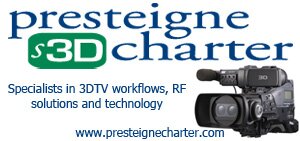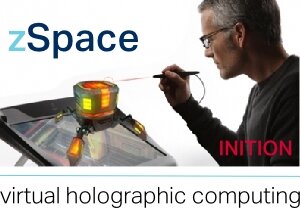“Mortician Last 3D Film for a While” Director Gareth Roberts
 Director Gareth Roberts has just completed the post production of the UK’s first independent 3D feature – The Mortician.
Director Gareth Roberts has just completed the post production of the UK’s first independent 3D feature – The Mortician.
Starting off as a runner for music videos, Gareth Roberts soon produced his own low budget music video which led to another leading to a career of directing professional music videos for a number of years. This took him into directing commercials which he became despondent with as filmmaking was his passion. In 2008 he developed his first low budget feature film – Kill Kill Faster Faster – a New York tragic love story based on the novel by Joel Rose of the same name. Three years later, Gareth Roberts has finished his first 3D feature but, although he is still a bit advocate of 3D and its future, he says that The Mortician 3D was his first and possibly last 3D project.
EXCLUSIVE
3D FOCUS: Tell me the synopsis of The Mortician 3D.
GARETH ROBERTS: The Mortician is essentially a gritty urban noir. It is set in a bankrupt American city where the infrastructure has collapsed and it's pretty much a lawless ghetto. It's just one step away from what actually could have happened if the banks had bankrupted and hadn't been bailed out. It's kind of a fairy tale really. I decided to shoot it in 3D because I've been a big advocate of 3D for years.

3D FOCUS: Is this your first 3D feature?
GARETH ROBERTS: It's my first 3D feature and could possibly be my last for quite a while!
I believe 3D has a use just beyond spears flying out of screens and people doing back flips on the dance floor. I think it's got a whole range of uses that span from being very subtle to having very high shock or visual impact value. I am more interested in 3D when you get beyond the effects and the gimmicks and I just think people will tire of that pretty soon. What it allows us to do is move the cinema of language, because we've been working in the 3D realm since the advent of cinema. The whole language of cinema is based around 3 dimensions; the way that you light a film to create highlights and shadows to provide a sense of depth. We use different lens sizes in order to create different distances between objects and bring certain objects towards the camera. It's all designed to create a 3 dimensional effect. When you build sets, you consider where to place props and objects, the way you block actors and the way you have actors moving in and out of scenes. All this creates a world that actually has depth.

No one sets out to make a flat film. Film makers set out to make a film that has depth. So far, we have been hampered by the technology. Now what this technology allows us to do is open up. It allows us to create depth and physically create a 3D environment which the viewer can engage with.They can engage with the characters and engage with the environment. I was much more interested in exploring that rather than creating effects. I am very pleased and very proud of what we've done.
3D FOCUS: In The Mortician, did you use 3D to convey emotions that you couldn't have done in 2D?
GARETH ROBERTS: We could have done it using conventional cinematic tools. We could have done it in 2D through lighting, blocking, etc. but we just did it more effectively in 3D. 3D offers more impact to a receptive audience but it does polarise people. People either like 3D or they don't like 3D. But audiences who are open to 3D are drawn much more into the story and places them into that world. It allows the audience to look at that world in the same way they look at the world they walk around in. The whole way we look at and experience the world is based on 3 dimensional depth. In 2D you are asking your brain to take something that isn't 3D, decode and understand it as if it is in 3D. If you present something that is in 3D, you are removing one of those filters that the brain has to use in that process.

3D FOCUS: Many Directors prefer shooting in 2D because that is what they are comfortable with and as 2D – 3D conversion continues to improve without the problems of shooting native 3D, would you be up for shooting your next feature in 2D with possible later conversion in mind?
GARETH ROBERTS: I would be up for that, but it really depends on your budget for a conversion and who is doing it. There were about 7 shots in The Mortician that we had to post convert on.
3D FOCUS: Was that because of errors on the set ?
GARETH ROBERTS: It was errors with data rate correction. The 2D to 3D conversion company did a fantastic job. They charged us about $25,000 which was great, but to do an entire movie like that? The production budget on our film was under £2.5 million from start to finish. Our post budget was about £450,000. You would never be able to dimensionalise an entire feature film for that kind of money.
3D FOCUS: Why would you not want to shoot in 3D again?
The reasons for me not wanting to shoot in 3D again is primarily, at this stage, to do with the way the film is being received in terms of 3D by the market.

3D FOCUS: Was the market not ready for a non special effects based horror or animated 3D feature?
GARETH ROBERTS: I think it's too early to have done what we tried to do with The Mortician, precisely because it is not an effects movie and it's not an animation. The buyers are saying “What is our audience for this? We can't identify an audience for this”. They are not buying it or, if they are buying it, they are buying it in 2D.
3D FOCUS: When I searched for The Mortician on the Internet I noticed that the promotional literature does not shout out “the Mortician is in 3D!”
GARETH ROBERTS: Well, we would have liked to have been hailed as the first independent drama in 3D but we haven't found a distributor who is willing to take that risk, put their neck on the line and spend the money to promote it.
3D FOCUS: Presumably, a good proportion of any film’s profit comes from TV, VOD and Blu-ray distribution. Do you think The Mortician will get a return on its investment in the longer term?
GARETH ROBERTS: I think in the long term it will. In ten years all the major channels will be rolling out 3D and they will be buying 3D content. So hopefully in the long term it will do business in TV, Blu-ray, etc.
3D FOCUS: What was the timescale for The Mortician 3D?
GARETH ROBERTS: I started writing it in 2005 and we started fund raising on it in 2007. We shot it in the end of 2009. 2010 we spent the majority of the year post-producing it and then this year we've been trying to sell it.

3D FOCUS: Do you have a UK Distributor now?
GARETH ROBERTS: We're in the process of getting a deal with a UK Distributor, a US distributor and a German distributor. We are just trying to lock it all together.
3D FOCUS: What rigs were you shooting on? Were you shooting parallel or convergence?
GARETH ROBERTS: We used a beam splitter on a Quasar rig. It was two REDs, one looking down onto a mirror and the other one looking through the mirror so it was a convergence stream. We used that primarily.
3D FOCUS: Did you find that the talent act differently with 3D?
GARETH ROBERTS: Not really, no. They tend to be interested in it to begin with and then they lose interest and they just focus on what it is that they need to do
3D FOCUS: What's your next project and do you feel slightly pessimistic about 3D after your experience on The Mortician 3D?
GARETH ROBERTS: I feel optimistic and pessimistic. I feel pessimistic about the short term but I am an optimist about the long term. Anyone who argues against 3D is like arguing against digital cinema, it's like arguing against sound, it's like arguing against colour. It's just one of those technological waves that is with us to stay. It's just a matter of people understanding the technology, mastering its capabilities, not being scared of using it in diverse, interesting, subtle and unusual ways. It's about people embracing it and learning the language. 3D will just get better the more people do it.
UPDATE
Since the interview I asked Gareth Roberts one more question …
3D FOCUS: Finally, the likes of Mark Kermode are saying that 3D is already over. What is your reaction to that?
GARETH ROBERTS: 3D certainly isn't over, it's here to stay, there has been too much capital investment for it to collapse. We are in a period of transition. The initial gimmick of digital 3D is over, and there is a backlash. This is largely due to the exhibitors still charging excessive ticket prices for 3D. The exhibitors have to realise that they can no larger charge a premium for the novelty of seeing a film in 3D. They also have to realise that audiences are becoming more sophisticated in their expectations, and can no longer be fobbed off with dim images. The exhibitors have to invest in the technology to screen the 3D films properly. With the proliferation of 3D TV, cinemas will soon become the poor 2D cousins if they cannot respond competitively to 3D. 3D Blu-ray is with us, every new flatscreen TV is 3D capable, every major network has a 3D channel and is crying out for 3D content. I would like to shoot another 3D feature for sure, it's yet to be seen if this will be primarily for TV or for the silver screen.
Thank you Gareth Roberts for taking the time to be interviewed by 3D Focus!
FREE WEEKLY 3D NEWS BULLETIN –



















